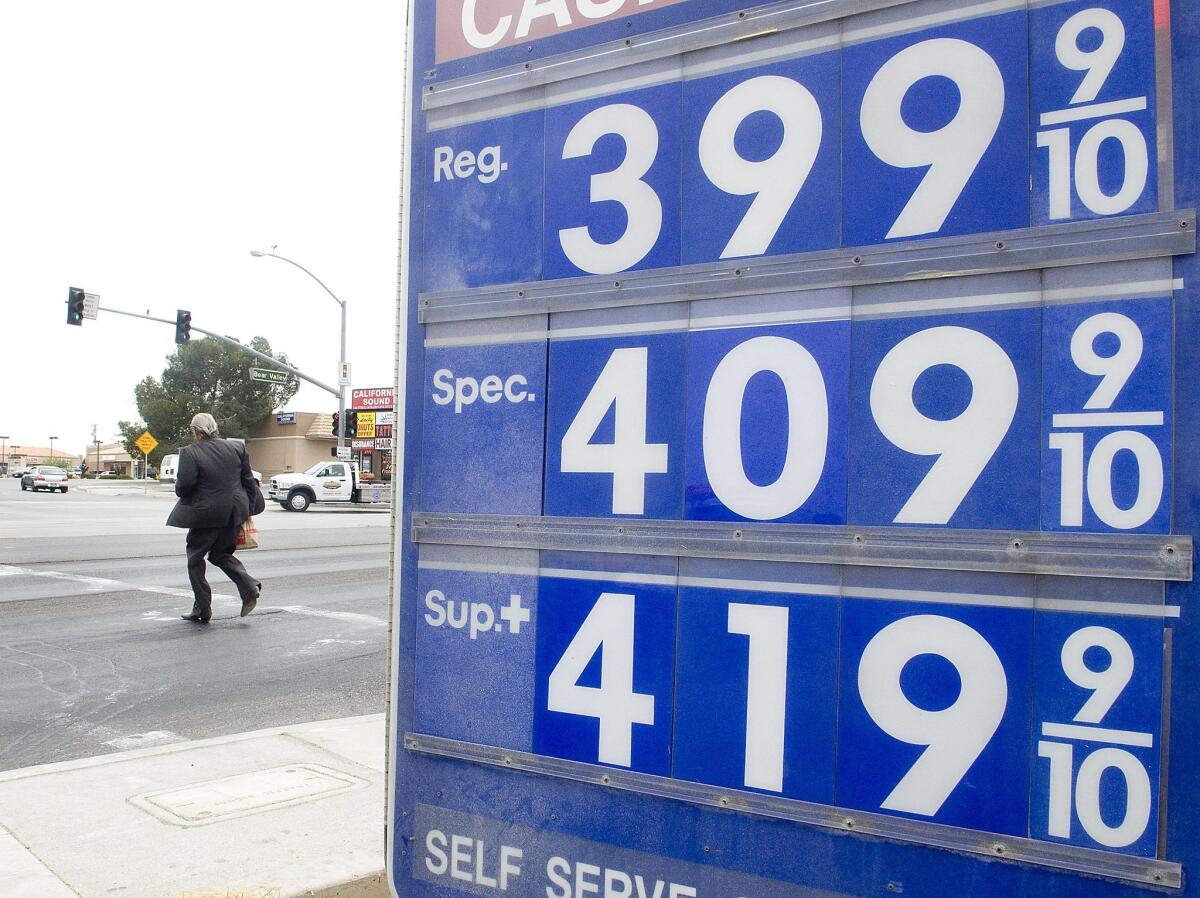Consumer advocates: Oil refiners manipulate California gas prices

Consumer advocates say that oil refineries’ price manipulation are to blame for California’s high oil prices.
- Share via
Filling up at the pump is often painful in California, where drivers tend to pay more for gasoline than in most other states.
Many industry watchers attribute the high fuel costs to unique forces — chiefly California’s clean-burning gasoline formula — that have isolated the market and kept it tightly balanced between supply and demand.
But some consumer advocates and politicians allege that price manipulation by oil refiners is to blame.
This year, price fluctuations were especially surprising. The price of crude oil began falling last summer, with pump prices following.
------------
FOR THE RECORD:
Gasoline prices: An infobox on the July 6 Business page in Section A listing factors that contribute to high California gasoline prices stated that motorists in April drove 31.1 million vehicle-miles on California roads, the most in the nation, and that Texas came in second at 21.9 million vehicle-miles. Those statistics should have been in billions. —
------------
In February, Tesoro Corp. idled its Northern California refinery in Martinez after a nationwide union walkout. Next, Exxon Mobil Corp. scaled back operations at its Torrance facility when an explosion damaged an air pollution monitoring unit.
Average pump prices shot up nearly a dollar before floating back down. Last week, a gallon of regular gasoline cost an average of $3.44 in California, more than 20 cents lower than a week earlier and about 70 cents lower than a year earlier, according to AAA. But drivers in the state are still paying nearly 70 cents more than the national average.
Whether those higher prices are a natural economic reaction or a sign of collusion between companies is up for debate.
Jamie Court, president of Santa Monica consumer advocacy group Consumer Watchdog, thinks something smells rotten.
“The public is used to paying $4 a gallon for gas but doesn’t realize that with crude at $60 a barrel, the gas price should be a dollar less than it is right now,” he said. “Unless you drive through another state, you don’t realize how outrageous it is.”
Part of the problem, Court said, is that the state has a small group of companies able to set prices as they please — the definition of an oligopoly.
“No one would argue this is a competitive market — but that doesn’t mean there’s not concerted action, possibly through a tacit agreement, to raise gas prices artificially,” Court said.
Evidence of possible price manipulation includes a recent streak of high premiums charged to brand-name stations by refineries, he said.
Those stations — the Chevron, Valero and Arco stops often prominently placed by freeway exits and at major intersections — usually pay a bit more than independent stations for gasoline in exchange for use of a recognizable name and special fuel additives. Over the last 16 years, the average gap has been 3 cents a gallon, Court said.
Since May, that difference has turned into a 30-cent chasm sustained over several weeks — an occurrence seen only three times since 1999 and never for more than a single week, he said. Court said higher premiums at branded stations lift prices at all stations.
In addition, refiners are exporting record amounts of fuel to other countries and are keeping inventories low, Court said.
“These companies are pulling out all their tricks,” he said.
This year brought an unusual number of refinery outages — 11 from the beginning of February to the end of May, according to Court.
Some were caused by unpredictable incidents, such as the blast in Torrance. But Court questioned why Tesoro would idle its Martinez, Calif., plant in response to a walkout when other affected companies, such as Valero, kept operations going.
“Rational economic behavior to an oil company can be price manipulation in another context,” he said.
But proving collusion is difficult.
Court and his allies, including billionaire activist Tom Steyer, say the industry is opaque. Even the Petroleum Market Advisory Committee, a group of experts gathered by the California Energy Commission to investigate price swings and effects on consumers, is limited in what raw data it can access from companies.
Refiners don’t need to disclose directly to the government when they plan to close for maintenance or when they want to hike prices. Steyer has mulled the viability of a possible ballot measure that would require more transparency on pricing and supply.
“They have to open their books — there are a lot more questions here than there are answers and we need a full accounting,” Steyer said. “We’re not talking about a small, discretionary amount of money for working people in California who have to commute to their jobs.”
After Court presented his case at a Petroleum Market Advisory Committee meeting in Berkeley last week, the Western States Petroleum Assn. trade group hit back.
“Consumer Watchdog has made numerous inflammatory and inaccurate allegations this year about transportation fuel markets,” spokesman Tupper Hull said.
“The petroleum industry on the West Coast has been the subject of dozens of investigations over the past few decades by organizations and individuals with far more knowledge and understanding of fuel markets than Consumer Watchdog and none of those investigations has ever found evidence of anti-competitive conduct,” he said.
California state senators have for years held meetings and launched preliminary probes on the subject of price fixing and market manipulation, even asking the U.S. Justice Department in 2012 to examine refineries one by one. The efforts, including a hearing in March, have been inconclusive.
When companies act independently of each other, savvy business behavior is expected and even encouraged, experts said.
“In a concentrated market, they’re going to naturally take into account that when they reduce their output a bit and no one else can fill in, their output affects price,” said Severin Borenstein, a professor at UC Berkeley’s Haas School of Business who sits on the Energy Commission’s advisory committee. “It’s not illegal as long as you’re not talking to other companies.”
The widening disparity between gasoline prices charged by refiners to branded and unbranded stations is “a much longer and larger differential than we’ve generally seen, and it’s something worthy of further investigation,” Borenstein said.
But he said Court’s conclusion that price manipulation may be at play is “a leap.”
The prices paid by branded stations always adjust more slowly to an overall decline in prices than their independent counterparts because refiners are exercising their prerogative to “hold prices up as their costs decline,” Borenstein said.
He also doesn’t buy the narrative that refiners anticipated market disruptions in February and decided to export gasoline to tamp down inventory levels. An “equally or more plausible explanation” is that prices were so low in California that refiners thought the smartest business decision was to export gasoline rather than hang on to it, he said.
Borenstein said he’d like to see more thorough data reporting, but cautions that open information could be a “two-edged sword.”
“It would be much easier for the few major companies that produce gasoline in California to coordinate their behavior, to monitor whether competitors are exercising discipline or trying to grab more market power,” he said.
Looking ahead, he said legislators could consider how to create an industry with more gasoline refiners and import options to limit the temptation for any one firm to try to withhold output to raise prices.
“The policy response is not to prosecute refiners for antitrust but to figure out how to make the market more competitive,” he said.
More to Read
Inside the business of entertainment
The Wide Shot brings you news, analysis and insights on everything from streaming wars to production — and what it all means for the future.
You may occasionally receive promotional content from the Los Angeles Times.











